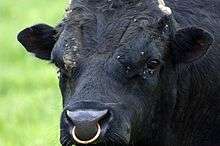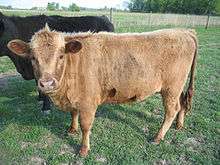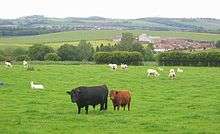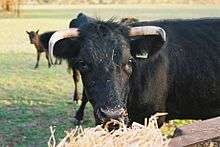Dexter cattle

Dexter cattle are a breed of miniature cattle originating in Ireland.[1] The smallest of the European cattle breeds, they are about half the size of a traditional Hereford and about one third the size of a Friesian (Holstein) milking cow. A rare breed until recently, but are now considered a recovering breed by The Livestock Conservancy.[2]
History and description

The Dexter breed originated in southwestern Ireland from which it was brought to England in 1882. The breed virtually disappeared in Ireland, but was still maintained as a pure breed in a number of small herds in England and also in the US. The Dexter is a small breed with mature cows weighing between 600 and 700 and mature bulls weighing about 1,000 pounds (450 kg). Considering their small size, the body is wide and deep with well-rounded hindquarters. Dexters come in 3 colors, black, red, and dun (brown). Dexters should have no white markings except for some very minor white markings on the belly/udder behind the navel and some white hairs in the tail switch. While many Dexters are naturally hornless (polled), many have horns that are rather small and thick and grow outward with a forward curve on the male and upward on the female. The breed is suitable for beef or milk production, although individual herd owners often concentrated on growing either one or the other.
Traits


Dexters are classified as a small, friendly, dual-purpose breed; used for milk and beef. However they are often listed as a triple-purpose breed, since they are also used as oxen. Management practices vary by breeder and by country. Their versatility is one of their greatest assets, and probably has something to do with the number of countries Dexter cattle are found, including North America, South Africa, Australia, and much of Europe.
Beef animals in the US are expected to mature in 18 - 24 months and result in small cuts of high quality lean meat, graded US Choice, with little waste. The expectable average dress out is 50 to 70 percent. The beef produced by Dexters is well marbled and tends to be darker.[3]
Dexters produce a rich milk, relatively high in butterfat (4%) and the quality of the milk overall is similar to that of the Jersey. Some claim the milk is more naturally homogenised than other milk due to the smaller fat globules. Dexters can reasonably be expected to produce 1.5 to 2.5 gallons (7.6 to 9.5 litres) per day.
The cows are exceptionally good mothers, hiding their calves almost from birth if there is any cover for them to hide. Some will produce enough milk to feed 2–3 calves, and often will willingly nurse calves from other cows. They are known for easy calving. This trait, along with the smaller size of the calf, has produced a small but growing market in the United States for Dexter bulls to breed to first calf heifers among the larger beef breeds to eliminate problems at parturition.
Some Dexter cattle carry Chondrodysplasia (a semi-lethal gene), which is a form of dwarfism that results in shorter legs than non-affected Dexters. The Chondrodysplasia affected Dexters are typically 6–8 inches shorter in height than non-affected Dexters. Care should be taken to avoid breeding two Chondrodysplasia affected Dexters together as there is a 25% chance that the fetus can abort prematurely. A DNA test is available to test for the Chondrodysplasia gene by pulling tail hairs from the animal.[4]
The aborted fetus is commonly called a bull-dog; a bull-dog is a still born calf which has a bulging head, compressed nose, a protruding lower jaw and swollen tongue as well as extremely short limbs.[5] There are higher frequencies of bull-dog fetuses born with black coats then red coats, this is because black coat colour is the more common colour of this breed.[6] Short-legged dexter cattle are considered to be heterozygous while bull-dog fetuses are homozygous for chondrodysplasia genes.[7]
Dexters can also be affected with PHA (Pulmonary Hypoplasia with Anasarca) which is an incomplete formation of the lungs with accumulation of a serum fluid in various parts of the tissue of the fetus. Unlike Chondrodysplasia, which has many physical signs, PHA shows no outward signs and is only possible to detect through DNA testing. As with Chondrodysplasia, PHA affected Dexters should not be bred together.[8]
Originally, Dexters were typically horned, however a naturally hornless polled strain was developed in the 1990s.[9]
Dexter cattle have short legs compared to other breeds; increased shortness is displayed from the knee to the fetlock.[5]
Dexter cattle are very hardy, efficient grazers and are able to thrive on poor land.[6]
Growing popularity

Once very rare in both the UK and the US, Dexters have been enjoying a resurgence in both countries, with over 4,100 Dexter cows registered in 2007 by the Dexter Cattle Society in the UK – double the figure for 2000.[10] "With high food prices, they are actually quite an attractive option if you like producing your own food,” said Sue Farrant, owner of four Dexters.[10] "Both my husband and I have full-time jobs so we're keeping them on the side as an interest. They do largely look after themselves and they've been hugely popular with the children."[10]
The popularity of Dexters has been fuelled by a desire for organic food, health concerns over factory farming, and soaring food prices.[10] "The government has no interest in where our food comes from or how it tastes, so it's nice to set your own welfare and quality standards,” said poet and songwriter Pam Ayres, who has a small herd of Dexters on her 20-acre (81,000 m2) Cotswolds property.[10] "If you've got a bit of land, a breed like the Dexter can work out a lot cheaper than the supermarket, plus they do a pretty good job of mowing the lawn."[11]
Breeding back the aurochs
The aurochs is an extinct type of large wild cattle that inhabited Europe, Asia and North Africa. It is the ancestor of domestic cattle. The species survived in Europe until the last recorded aurochs died in the Jaktorów Forest, Poland in 1627. Approaches that aim to breed back an aurochs-like phenotype do not equate to an aurochs-like genotype. In 2015, researchers mapped the draft genome of a British aurochs dated to 6,750 years before present. Researchers compared the genome to the genomes of 73 modern cattle populations and found in traditional or landrace cattle breeds of Scottish, Irish, Welsh and English origin - such as Highland, Dexter, Kerry, Welsh Black and White Park - carry the ancestry of the sequenced aurochs but the other populations did not.[12][13] Another study concluded that because of this genomic introgression of the aurochs into these breeds, if this reflects "the bigger picture across the aurochs/cattle range, perhaps several sup-populations of aurochs are not extinct at all." The study proposed that it will be possible to consider breeding back Bos "that are genetically akin to specific original aurochs populations, through selective cross-breeding of local cattle breeds bearing local aurochs-genome ancestry."[13]
In popular culture
In the novel Touch Not the Cat, by Mary Stewart, a farmer character describes Dexters as "[t]ricky-tempered beasts."
See also
References
- ↑ "American Livestock Breeds Conservancy Priority Watch List". Retrieved 14 September 2008.
- ↑ "Dexter Cattle", livestockconservancy.org
- ↑ Oklahoma State University. "Dexter Cattle". Retrieved 14 September 2008.
- ↑ http://dextercattle.org/adca/adca_article_chondrodysplasia.html
- 1 2 Crew, F. A. E. (1923-01-01). "The Significance of an Achondroplasia-Like Condition Met with in Cattle". Proceedings of the Royal Society of London. Series B, Containing Papers of a Biological Character. 95 (667): 228–255.
- 1 2 Crew, F. A. E. (1924-01-01). "The Bull-dog Calf: A Contribution to the Study of Achondroplasia". Proceedings of the Royal Society of Medicine. 17 (Sect Comp Med): 39–58. ISSN 0035-9157. PMC 2201457
 . PMID 19983950.
. PMID 19983950. - ↑ Harper, Paw; Latter, Mr; Nicholas, Fw; Cook, Rw; Gill, Pa (1998-03-01). "Chondrodysplasia in Australian Dexter cattle". Australian Veterinary Journal. 76 (3): 199–202. doi:10.1111/j.1751-0813.1998.tb10129.x. ISSN 1751-0813.
- ↑ http://dextercattle.org/adca/adca_article_pha.html
- ↑ Nanci, Gabriella; Millman, Stefani (2009). Dexter Cattle: A Breeders' Notebook Volume One. Bloomington, Indiana, United States: www.AuthorHouse.com. pp. 86–87. ISBN 978-1-4389-8341-7.
- 1 2 3 4 5 Times Online. "Just right for the garden: a mini-cow" by Chris Gourlay. August 17, 2008.
- ↑ City Farmer. "Just right for the garden: a mini-cow" by Chris Gourlay. August 17, 2008 (updated link)
- ↑ Park, Stephen D E; Magee, David A.; McGettigan, Paul A.; Teasdale, Matthew D.; Edwards, Ceiridwen J.; Lohan, Amanda J.; Murphy, Alison; Braud, Martin; Donoghue, Mark T.; Liu, Yuan; Chamberlain, Andrew T.; Rue-Albrecht, Kévin; Schroeder, Steven; Spillane, Charles; Tai, Shuaishuai; Bradley, Daniel G.; Sonstegard, Tad S.; Loftus, Brendan J.; Machugh, David E. (2015). "Genome sequencing of the extinct Eurasian wild aurochs, Bos primigenius, illuminates the phylogeography and evolution of cattle". Genome Biology. 16. doi:10.1186/s13059-015-0790-2.
- 1 2 Sinding, Mikkel-Holger S.; Gilbert, M. Thomas P. (2016). "The Draft Genome of Extinct European Aurochs and its Implications for De-Extinction". Open Quaternary. 2. doi:10.5334/oq.25.
External links
| Wikimedia Commons has media related to Dexter cattle. |
- Dexter Cattle Society UK
- American Dexter Cattle Association
- Dexter Cattle Society New Zealand
- Purebred Dexter Cattle Association
- Dexter Cattle Australia
- Canadian Dexter Cattle Association